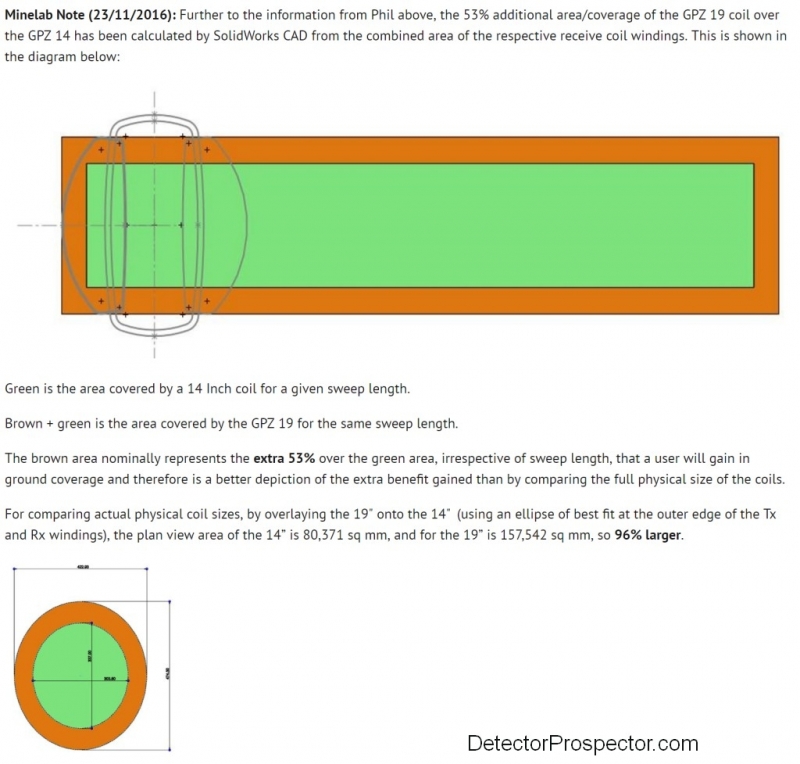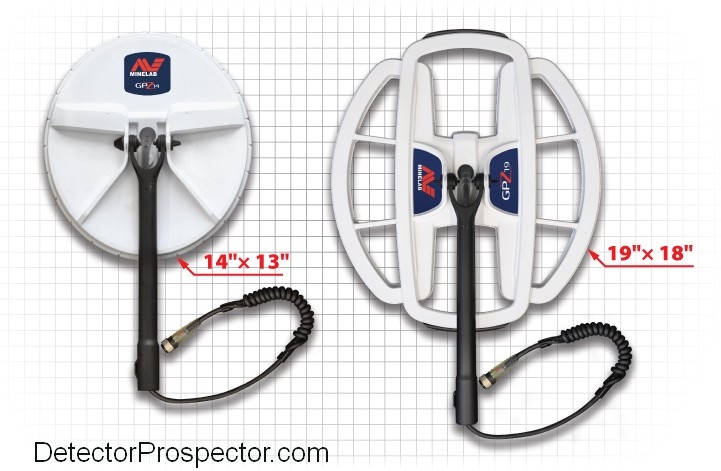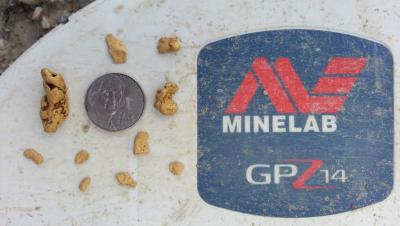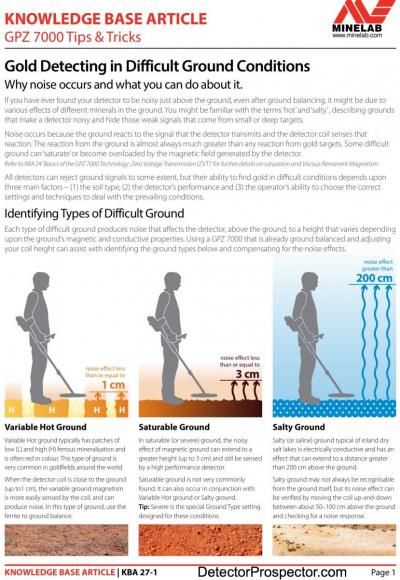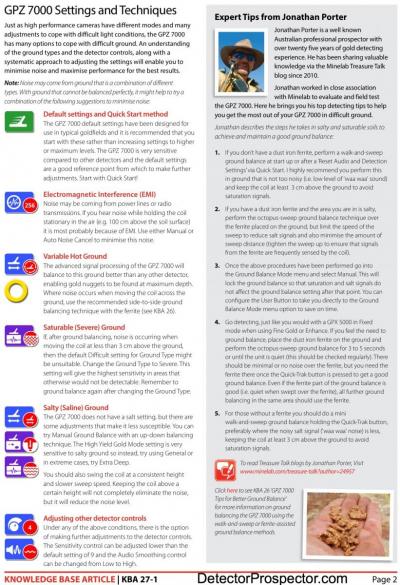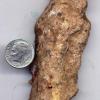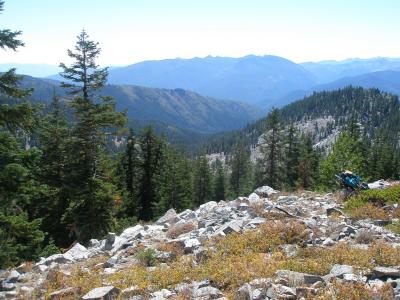Search the Community
Showing results for 'ground balance'.
-
Jason made a comment on another thread about the virtues of not getting bogged down hunting small gold. I wanted to comment without getting off topic so here goes. In my opinion big nuggets generally go to the first coil over them. They are big and so kind of hard for any good detector to miss. Let's say there is a nugget that a detector can hit at 20". That means as long as any of those nuggets or larger exist in the top 20" you get them. Now you go back and hunt with a machine that can hit those same nuggets to 24". The problem is for all intents and purposes you are now detecting only 4" of additional depth, and the odds of one of those targets being in 4" of ground is far less than the odds of one being in 20" of ground. And in fact due to the way many desert placers form, your odds are even worse because many desert placers get leaner the deeper you go. Those big deep nuggets of your imagination may just not be there, as has been proved by many (not all) failed bulldozer pushes. There is therefore a lot to be said for Jason's method of covering lots of hopefully virgin ground fast with larger coils to go for the larger gold even if you give up some depth doing it. I spent much of my detecting career hunting like that. The problem is pretty simple. It is getting very hard to find virgin ground that has good enough gold for this method. Days if not weeks can pass between decent finds, making this only for people with lots of time and extreme patience. My method now generally has shifted to cleanup mode. Hunting slowly and methodically chasing smaller gold with the GPZ with the idea that any deeper nuggets I get over will take care of themselves. Oftentimes for most well hunted areas that means only getting small gold but at least I am finding gold, and the GPZ hits about as small as anyone could wish. And if a larger one comes along I have high confidence I will nail it easily enough. As anyone can attest however, those big ones are getting very rare. Novices in particular I have to recommend slow and careful, going for the small stuff. Finding gold, any gold at all, is an extremely important confidence builder and essential if the novice is not going to quit the game after only a few outings. If money is no object, there in my opinion is no surer way to get some gold than to get an SDC 2300 and go as slow and as methodically as possible with it. If you can't find gold with a 2300 you are in entirely the wrong locations, or electronic prospecting simply is not for you.
-
Minelab just updated the October 26 blog entry at http://www.minelab.com/usa/go-minelabbing/treasure-talk/the-gpz-19-coil-does-it-really-detect-30-deeper to add the following information at the end of the entry. Note that to get good coverage it is the smaller receive windings that matter, not the larger center transmit winding.
-
I'm not sure if it's coincidental but since the update I've run into a number of areas that cause a strange oscillation on the GPZ. Basically, I can set the coil on these pieces of ground and not move it at all and it will just go "wee-woo-wee-woo" constantly and loudly as if there is a target underneath, it never balances out, manual or auto. Rebalancing over the ferrite does not seem to affect it, wether the ferrite is over that spot or away from the spot. At first it was small spots and I thought it was EMI related, but now I've found entire washes that do it, yet the next wash over is fine. I was inclined to think it was due to salt, but there is so little salt around here that I went ahead and tasted some of the dirt (yep) and it wasn't salty. Usually I can taste salt if its bad enough to interfere with my machines. These washes have a lot of black sand and a lot of banded iron formation chunks laying about. usually running in normal and switching to difficult takes it away for the most part but sometimes it's still there. Just odd that it never balances out. Has anyone else run into ground like that before? Most bad ground won't sit there and oscillate if you stop moving the coil even if its bad enough to not balance out.
-
On the Minelab website at http://www.minelab.com/usa/treasure-talk/gpz-7000-ground-tracking-software-update "It’s now been a couple of weeks since the update was released and there are already some good reports coming in from around Australia, where many users have carried out the upgrade and seen noticeable performance improvements. For everyone who has not carried out the upgrade yet – I recommend you do so, along with using the yellow ferrite as part of the ground balance procedure. This will ensure you maximise your GPZ’s ability to extract gold signals from the ground noise." Original software – February 2015 (Control Panel: 1.0.8-57) Ground Tracking Update – October 2015 (Control Panel: 1.2.8-98)
-
I have been hunting with the GPZ for quite some time now. So I the am use to the GPZ being noisy it's like running the GPX 4500 very very hot or (maxing out). On this particular day the ground was saturated and as I dug down to recover a target I never hit any dry dirt. The GPZ will find the gold in wet conditions if you listen to what it's telling you through the noise. A proper ground balance and using the ferrite ring is a key part. On this outing I recovered 8.8 DWT and the largest being 5.4 DWT. The quarter ounce piece was at thirteen inches and broad signal. Happy Hunting, Road Dog
-
Interesting thread over on Rob's forum: http://forums.nuggethunting.com/index.php?/topic/11962-what-are-you-missing-gpz/ These settings have been discussed extensively, but I have never seen a post indicating significant amounts being missed by running in "Difficult". Seems strange to think you could miss targets by trying to run quiet so you could better hear whispers. Still baffled by GPZ.
-
My recommended GPZ 7000 Ground Balance Method for Salty Saturable soils: 1. If no "Dust Iron" Ferrite, perform a "Walk and Sweep" at start up or after a "Reset Audio and Detection Settings" via Quick Start. I highly recommend you perform this in ground that is not too waa waa (salty) and keep the coil above 30 mm to avoid saturation signals. 2. If you have a "Dust Iron" Ferrite and the area your in is Salty, then perform the Octopus sweep over the Ferrite laying on the ground but limit the speed of the sweep to avoid salt signals and also minimise the amount of sweep distance (tighten the sweep up). 3. Once the above procedure has been performed go into the "Ground Balance Mode" menu and select Manual, this will then lock the GB so that Saturation and Salt signals do not affect the GB after that point. You can configure the USER button to take you directly to the Ground Balance mode menu option to save on time if you like. 4. Go detecting just like you would with a GPX 5000 in Fixed Mode using Fine Gold or Enhance. If you feel the need to ground balance place the "Dust Iron" Ferrite on the ground and perform the Octopus sweep for 3 to 5 seconds or until the unit is quiet (this should be checked regularly). There should be minimal or nil noise over the Ferrite but you need it there once the Quick Trak button is pressed in to get a good GB even if the Ferrite part of the GB is still good. For those without a Ferrite you should do a mini "walk and sweep" with Quick Trak held in, preferably where the salt signal (waa waa noise) is less, keeping the coil above 30mm to avoid Saturation signals. Notes: By using Manual mode you stop the Salt and Saturation signals from interfering with the GB, salt signals can throw the GB out if in tracking mode, this also happens on a GPX 5000 when in Tracking mode. If the detector is exposed to strong Salt and Saturation signals when the Quick Trak button is depressed you could end up with an atypical Ground balance which is not good for effective metal detecting. People need to take into consideration the GPZ's ability to sample very early, due to this it's more aggressive on Salt signals and Saturation signals (probably by a magnitude of 2 or more but not as bad as a VLF), hence operators need to keep that in mind in Alkali or Saturable ground. By using Manual mode and attaining a good GB at start up and maintaining it by regularly checking with the Ferrite during the session you will not have to worry about Salt or Saturation signals affecting the GB. A slower sweep speed has always helped with salt so be prepared to slow down, salt signals vary from ground to ground even over small distances. If unsure it is salt your dealing with just lift the coil to waist height away from your body and listen for a faint to loudish broad signal, if so Salt is present. JP
-
Many of the prospectors here sometimes prospect in Northern Nevada, and like a number of GPZ users prospecting in northern Nevada, I have been experiencing issues in certain places with the GPZ moaning and groaning over wet ground that is a little bit salty. The amount of salt in the ground at various places in northern Nevada ranges from not salty at all to fairly salty with all ranges in between. When fully dried out this ground is no problem, but when wet it is a whole different story. Some places the salt is no issue, while in others it is very noticeable. Salt, by itself, is not conductive and dry salt will not respond to a metal detector, but when dissolved in water the salty solution is conductive. The extreme of this is wet ocean beach sand. The salty placer areas of northern Nevada are not nearly as salty as ocean beach sand but they have proven to be salty enough to cause the GPZ to have difficulty with this ground. Here in Northern Nevada we have had an unusually wet period of about the last six weeks. Much ground is now saturated wet and in places there are even puddles of standing water. Even where the surface is dried out, an inch or two below the dry surface crust the ground is fairly damp. I was camped recently in an RV park in the Pershing / Humboldt County gold areas of northern Nevada and was approached by GPZ owners also staying in the same park expressing their concerns about the GPZ ground balancing in these areas of salty wet ground. A good ground balance with a stable and quiet threshold cannot be achieved in these areas. A slow swing speed is the best way to deal with the groaning at present. Slowing way down does greatly reduce the groaning, but it does not totally eliminate it. The good news is that once this ground dries out fully, the GPZ will have no problem with the ground. The downside of this is that we have had so much rain in the last six weeks that it will likely take more than a month of dry weather before the ground dries out to the point where the salt will no longer be an issue. So I wanted to make some tests to determine what level of problem the salty ground is really causing out here in northern Nevada. A while back, Steve found a nugget patch in northern Nevada. I will not say where or exactly when that occurred, but the ground is salty and does groan quite a bit with the GPZ when its wet. In some spots on this area the wet ground really does make quite a bit of noise. Steve gridded the spot very carefully with his GPZ, and I walked around on it afterward with my GPZ and did not find any additional gold – he cleaned it very well. However, we have had a lot of rain in the last two months and I consider this an excellent spot to try out an alternative to the GPZ to see if the salty ground would cause targets to be missed. I wondered if there might be very small bits that the GPZ had missed because the groaning ground overwhelmed the target response of small targets. I figured the SDC 2300 would be a great alternative to see what, if anything, the GPZ might have left behind. So I took my SDC 2300 to the spot to see what I could find. First, I will say that even in the non-salt mode, the SDC 2300 did not have nearly the same level of difficulty with the salt. In the salt mode, the SDC was nice and quiet. I have to admit that the nice quiet threshold of the SDC was a lot more pleasant to listen to than the moaning and groaning of the GPZ. I went over the spot fairly well with the SDC and found a number of very small pieces of trash, the vast majority of which were tiny pieces of steel window screen manufactured with a wire less than a quarter of a millimeter in diameter. I did find one small nugget which weighed 0.22 g on my very accurate scale. Here is my conclusion after testing the SDC with its salt mode versus the GPZ on salty ground with comparatively shallow gold: First, Steve didn't miss much. Even though his detector moaned and groaned (and my GPZ did too), he was hearing essentially all the targets in the ground. He may have missed one very small nugget, and the window screen wire bits were very small and near or possibly below the limit of what the GPZ could hear anyway (I think on these tiniest of targets, the SDC is a bit more sensitive). My conclusion about this testing was that if you know what to listen for and listen carefully on that salty Northern Nevada ground, you are not missing much of anything with your GPZ. The ground noise may be annoying to listen to, but if you're listening carefully you're not missing much. I now have more confidence in my GPZ going over these grounds – it will be nice however when the ground dries out and the groaning goes away.
- 32 replies
-
- minelab sdc 2300
- minelab gpz 7000
-
(and 1 more)
Tagged with:
-
I was detecting over the weekend with my Garrett ATX near Redding. The ground was moist and was mostly a reddish-orange clay like soil from the decomposed shale bedrock I am assuming. When I moved away from the creek bottom (gravels and bedrock) and went up on the hillside or in tributary gulches I would encounter soil areas that made the detector constantly give a target signal or what I would say is a mineralized ground wine or squeal. I tried ground balancing several times, but it did not alleviate the problem. Ended up shutting down the machine and relocating, basically starting over in a new area where I could maintain a normal threshold sound. I have used the machine for about a year and this has happened a couple times, but it happens infrequently. The first time it happened I had a low battery and figured it may have been a symptom of a low battery. Any ideas, similar experiences, and/or tips using the ATX would be appreciated. Thanks in advance.
-
I'm pretty new at chasing the yellow stuff with approx. 200hrs gpz use under my belt & reading detector prospector forum with much interest & learning lots. Thank you all !! I have been detecting a patch over the past month getting 1 & 2 gramers here & there, unfortunately at the moment due to work commitments i can only detect during the day. Using the zed factory pre-set setting and adjusting the sensitivity, ground type & audio smoothing on or off, was wondering if someone could help answer these questions. Does the temperature of the ground influence the clarity & or the signal strength ? If i come back in winter when the ground is colder will the ground noise be less ?. How about freshly rain soaked ground !! does that make a difference to GN or signal strength. Cheers ozgold
-
Hey guys, I'm and european metaldector searcher who is searching with my XP Deus I especially like to try to search in highly mineralized and/or magnetic soils. As far as I know, these types of soils/grounds are found in parts of the USA and particularly in Western Australia and other parts of Australia. Unfortunately, I have never visited these sides in the USA and Australia yet... Hopefully it will be soon! I´m really curious what ID numbers you guys get while you are groundbalancing on this difficult soils with your XP Deus. Greetings! Roberto
-
Heading to Rye Patch for the weekend and bringing my Nokta with and just curious as to the best size coil to use...am I looking deep ...shallow or what???? I've heard things like going over with a big coil then over the same area with the smaller coil....honestly this is where inexperience green comes in...thnx
-
G'day All I have just been Testing the GND readings On My MXT and My GMT and naturally they don't Match?? Anyway the MXT read 84 to 85, But the thing that has me Thinking Is with the GMT If I have the 6x10 Long Scan coil on it I get a reading of 65, but If I put the Twin D Coil on it I get A Reading of 78, So If DD's are meant to be Better In Hot Ground, Then why does the Concentric give A Lower Ground Phase Reading Than The DD, I am starting to think that Concentric Coils are just as Good In Hot Ground BUT ??? because they are more sensitive that they pick up More Noise, And the fact that they are more Sensitive they Give A Truer Ground Reading?? I know that the 6X10 Long Scan see's things that you would normally find with the Little Shooter Coil, Which is another reason why the GB 2 Is So Hot on Tiny Gold. But It is those GND Readings that are making me think this way. John
-
When I was out detecting in Rye Patch last month with the GPZ I had a really hard time dealing with the wet/salty/mineralised soil. I just re-read an eye-opening tip from JP on another forum and was wondering if anybody else was keeping their coil off the ground. http://golddetecting.4umer.net/t21493-how-to-remove-noise-from-debris-gpz-7000 JP recommends to not scrub the ground and keep the coil 20 to 30 mm off the ground when swinging the coil. Bill
-
So I've tried this a few times and every time it's ended up being trash, but this time it was a good one. Of course I lost patience by this point after a few days of trying and didn't go through the whole routine and test a ton of settings like I had been doing but I still got a few in for reference. But I ran over in HY, General, Extra Deep. And then Normal and Difficult in High Yield. After about 2:30 it's just some futzing around digging (and trying out my new pinpointer) so if you want to see what the nugget looked like for potential geometric type reference then you can skip all that junk and go to the end. I'm really not sure how all the previous PI's missed this one, it wasn't too incredibly deep, right out in the open next to a very potholed dig area, and it seemed like a typical slugo nugget. One side had a flat face though if that mattered, and one side was spongy-ish. It went almost exactly 10 grams after soaking in CLR.
-
Steve and forum members, The ATX has 4 ground tracking settings, off, slow, medium, fast. The manual describes this as a continuous slow tracking of ground mineralization. It explains how to change settings, but really doesn't explain what it is doing and how to decide what setting to use and when to use. Is this auto ground balance, or something different? What is the significance of the slow, med, fast settings? Thanks for any info you can provide.
-
Posted by gullyhunter. That's very strange... unless he tracked out the target by pumping the coil?
-
When ground balancing with my previous metal detectors I am used to hearing the change in pitch of the threshold as the metal detector is being raised and lowered. With my SDC it barely makes any noise at all when ground balancing. Is there something wrong with my machine or is this normal for this unit? Chuck Strickland


